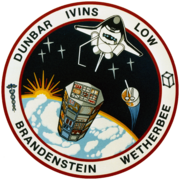STS-32

Columbia retrieves the Long Duration Exposure Facility
|
|||||
| Mission type | Satellite deployment Satellite retrieval |
||||
|---|---|---|---|---|---|
| Operator | NASA | ||||
| COSPAR ID | 1990-002A | ||||
| SATCAT № | 20409 | ||||
| Mission duration | 10 days, 21 hours, 36 seconds | ||||
| Distance travelled | 7,258,096 kilometres (4,509,972 mi) | ||||
| Orbits completed | 172 | ||||
| Spacecraft properties | |||||
| Spacecraft | Space Shuttle Columbia | ||||
| Launch mass | 116,117 kilograms (255,994 lb) | ||||
| Landing mass | 103,571 kilograms (228,335 lb) | ||||
| Payload mass | 12,014 kilograms (26,486 lb) | ||||
| Crew | |||||
| Crew size | 5 | ||||
| Members |
Daniel C. Brandenstein James D. Wetherbee Bonnie J. Dunbar Marsha S. Ivins G. David Low |
||||
| Start of mission | |||||
| Launch date | 9 January 1990, 12:35:00 UTC | ||||
| Launch site | Kennedy LC-39A | ||||
| End of mission | |||||
| Landing date | 20 January 1990, 09:35:37 UTC | ||||
| Landing site | Edwards Runway 22 | ||||
| Orbital parameters | |||||
| Reference system | Geocentric | ||||
| Regime | Low Earth | ||||
| Perigee | 296 kilometres (184 mi) | ||||
| Apogee | 361 kilometres (224 mi) | ||||
| Inclination | 28.5 degrees | ||||
| Period | 91.1 min | ||||
|
|
|||||


Clockwise from top left: Ivins, Low, Dunbar, Wetherbee, Brandenstein.
STS-32 was the 33rd mission of NASA's Space Shuttle program, and the 9th launch of Space Shuttle Columbia. Launched on 9 January 1990, it marked the first use of Launch Pad A at Kennedy Space Center's Complex 39 since 1986; it also marked the first use of Mobile Launcher Platform No. 3 (MLP-3) in the Space Shuttle program. STS-32 was, at the time, the longest shuttle mission yet conducted, with a duration of nearly 11 days. Before STS-32, the only mission of the same duration had been STS-9 in 1983. On 20 January 1990, STS-32 executed the third night landing of the shuttle program.
Launch Complex 39A was modified extensively in preparation for the launch, with STS-32 being the first launch from the refurbished pad since STS-61-C in 1986. NASA made improvements to the crew emergency system and the shuttle payload room, increased anti-freeze protection for the water systems, installed debris traps used during propellant loading, and added more weather protection features and an umbilical to provide power, instrumentation and controls to the heaters for the solid rocket booster field joints.
MLP-3, the oldest of the three Apollo-era launch structures, also underwent extensive remodeling for use with the shuttle. These modifications included the removal of the umbilical tower, the reconfiguring of three exhaust holes, and amendments to the electrical and mechanical ground support systems.
...
Wikipedia
